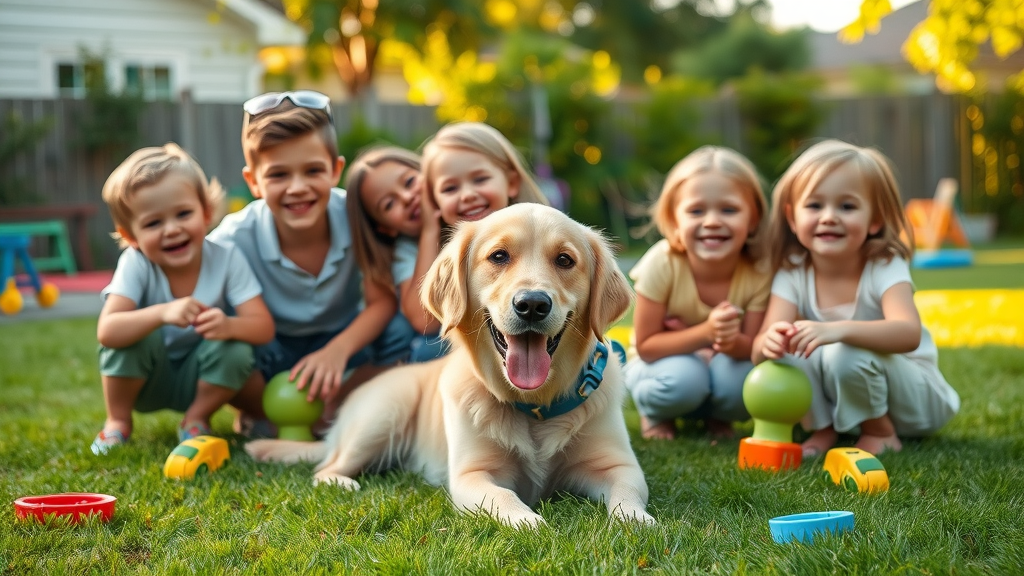Did you know? Over 67% of reported canine behavioral issues are rooted in the fundamental dog temperament of each individual pet, transcending training or breed expectations. Whether you’re a seasoned dog owner or considering a new furry friend, understanding dog temperament will transform how you connect, train, and build a lasting bond with your companion. Dive into the fascinating science of temperament and learn how to nurture a happy, well-adjusted dog.
The Surprising Role of Dog Temperament in Everyday Life
Dog temperament plays a pivotal role in shaping daily experiences for both owners and their pets . From the way your dog greets guests at the door to how it reacts during playtime or at the vet, temperament influences every facet of animal behaviour. For example, a friendly and outgoing dog may eagerly meet new people, while a more sensitive or shy dog might retreat when visitors arrive.
Understanding your dog’s natural tendencies isn’t just about avoiding unwanted behavior; it’s about building trust, enhancing training, and ensuring everyone in the household thrives . Temperament impacts how your dog responds to routine activities—like walking in the park, participating in a dog show, or simply learning to sit and wait for treats. Practical recognition of your pet’s innate personality helps you provide proper mental stimulation, appropriate responses, and the right amount of positive reinforcement. Ultimately, knowing what drives your companion’s dog behavior helps make your dog happier—and makes you a more confident, compassionate dog owner.

“Over 67% of reported canine behavioral issues are rooted in the fundamental dog temperament of each individual pet, transcending training or breed expectations.”
What You’ll Discover About Dog Temperament and Personality
- The foundational principles of dog temperament and how these shape your companion’s personality.
- How to differentiate temperament from learned behavior.
- The science behind temperament testing and practical examples.
- How to find a dog breed compatible with your lifestyle and temperament preferences.
- Answers to the most commonly asked questions about dog temperament.
Dog Temperament Explained: Understanding How Genetics and Environment Shape Your Companion
The Definitions and Core Concepts of Dog Temperament
Dog temperament is the set of innate behavioral responses and tendencies that an individual dog exhibits across different situations. Unlike learned habits, which emerge from training or environmental exposure, temperament is biologically based —reflecting underlying genetics, early development, and even selective breeding in dog breeds. These core concepts distinguish between what a dog is predisposed to do (temperament) versus what it has learned from experience or instruction (behavior).
Every individual dog demonstrates a unique blend of traits such as confidence, sociability, sensitivity, or independence. For instance, some dogs love being the center of attention at a bustling dog show, while others are content to sit and observe. Recognizing these characteristics of a dog is essential for responsible pet ownership, as it shapes your expectations and the way you interact with your companion. Temperament testing aims to precisely measure these innate tendencies so that both dog owners and trainers can better understand and foster positive animal behaviour.
The Relationship Between Temperament and Personality in Dogs
While “dog temperament” and “personality” are sometimes used interchangeably, they have several distinct differences. Temperament is the biological framework —the genetically influenced starting point—while “personality” encompasses the sum of temperament and all the learned experiences, environment, and upbringing that shape a dog’s full behavioral profile. Think of temperament as the canvas, and personality as the painting created by life events, training, and interactions.
Understanding this relationship is key for dog owners who want their pets to thrive. For example, a dog with an easygoing temperament may naturally adapt well to various situations, while one with a more reactive nature might need additional support, early socialization, or even the guidance of a canine behaviorist. By appreciating both the static and fluid nature of temperament and personality, you’re empowered to choose positive reinforcement training methods that cater to your dog’s individual differences, making every interaction more rewarding.

Dog Temperament by Breed: Why Genetics Matter
Exploring Dog Breeds: Common Behavioral Traits and Temperament Patterns
Throughout history, dog breeds have been carefully developed through selective breeding to enhance certain physical and temperament traits that made them more successful at jobs like herding, retrieving, or guarding. As a result, each breed exhibits a general temperament pattern, such as the golden retriever’s affable nature or the intense loyalty and drive of working dog breeds. Breed standard descriptions often reference expected behavioral tendencies—like a border collie’s mental stimulation needs or a bulldog’s easygoing attitude.
However, individual differences always exist within any breed . While breed dogs may share foundational traits, your pet’s personal temperament can still vary significantly due to early socialization, upbringing, and environment. Responsible breeders and shelters frequently conduct temperament testing to determine how the dog might react in a variety of scenarios. This helps dog owners find a canine companion that matches their lifestyle and expectations, whether they want a friend for family cuddles or a partner for high-level dog sports.
| Dog Breed | General Temperament | Common Personality Traits |
|---|---|---|
| Labrador Retriever | Friendly and Outgoing | Playful, gentle, eager to please, good with other dogs |
| German Shepherd | Courageous and Confident | Loyal, protective, intelligent, may need early socialization |
| Bulldog | Calm and Easygoing | Affectionate, docile, tenacious, great family pets |
| Border Collie | Highly Intelligent and Energetic | Focused, responsive, thrives on mental stimulation and training |
| Golden Retriever | Balanced and Adaptable | Friendly, tolerant, devoted, ideal for families |
| Chihuahua | Alert and Sensitive | Lively, sometimes timid, loyal to owners |
How Mixed Breed Dogs Present Unique Temperament Traits
Mixed breed dogs often display a fascinating combination of temperament and personality. Without a single predictable breed standard, these dogs inherit genes from various ancestors, leading to individualized behaviours and traits. This genetic diversity can actually result in stable, well-rounded temperaments—especially when early socialization and proper training are provided.
Owners of mixed breed dogs should observe, document, and interpret their pet’s unique reactions to new situations, people, or other animals. A professional trainer or canine behaviorist might recommend temperament testing to more accurately determine how the dog will respond in dynamic environments. Ultimately, understanding and celebrating the distinctive temperament of a mixed breed enables owners to create rewarding routines and relationships tailored to their pet’s needs.

Temperament Test: Measuring Dog Temperament and Predicting Animal Behaviour
What Is a Temperament Test for Dogs?
A temperament test is a structured process used by canine professionals to evaluate the natural reactions, social inclinations, and coping styles of an individual dog. Unlike training commands that teach a dog to sit and wait, these assessments measure how a dog responds to sudden noises, unfamiliar people, and new environments—offering predictive insight into future animal behaviour. Temperament testing is often used by shelters, breeders, and trainers to guide adoption decisions, training plans, or determine suitability for roles ranging from working dog to beloved family pet.
While temperament tests highlight consistent behavioral tendencies, they also help identify potential issues or strengths. For example, a confident dog may excel in a busy urban household, while a more reserved or sensitive pet might be happier in quieter settings. Accurate temperament assessment ensures that both human and canine expectations are met, helping your dog thrive in its forever home.
Methods and Tools: From Formal Temperament Testing to Observational Assessments
Professionals use a spectrum of methods for temperament testing , ranging from formal standardized protocols to ongoing informal observations. Standard tests might include introducing novel stimuli, exposing the dog to various people and environments, and evaluating reactions to handling or play. Some programs score dogs on scales of sociability, reactivity, and nerve stability, directly connecting findings to recommended training approaches or breed suitability. These formal tools are especially valuable in breed dogs and working dog selection, where specific temperament profiles are crucial.
However, real-life animal behaviour is just as important as test results. Long-term observation by dog owners and professional trainers, especially during key developmental periods, provides nuanced insights. Watching how a dog greets friends, copes with surprises, or participates in activities on this service helps determine the ideal training regimen. Continually assessing your dog’s temperament allows for tailored environmental enrichment and positive mental stimulation—no matter its breed or prior history.
Video: Watch a Dog Temperament Test in Action
Want to see temperament testing up close? This short video demonstrates a canine behaviorist guiding a dog through various scenarios, showing how professionals determine how the dog responds to new stimuli and environments. Watching these evaluations can help you better understand your own pet’s behavior and anticipate its needs.
Temperament and Animal Behaviour: Real-Life Impacts
How Temperament Influences Everyday Dog Behaviour
The impact of dog temperament reaches every corner of daily life, influencing everything from walks and playtime to interactions with other pets, children, or strangers. Dogs with a balanced, friendly temperament are naturally good with other dogs and adapt quickly to household routines. By contrast, those with more guarded or independent natures might show caution in new environments or require thoughtful introductions to changes—like meeting a baby for the first time or traveling to a new home.
As a dog owner, recognizing your companion’s innate characteristics helps you adjust training strategies and socialization efforts for best results. For instance, animals that struggle with anxiety or overexcitement may benefit from increased mental stimulation, short positive sessions, and greater structure. By ensuring proper outlets for your dog’s temperament and personality, you foster more predictable, harmonious animal behaviour and nurture a lasting, confident bond.
Case Study: Working Dog Temperament vs. Family Pet
Let’s compare the working dog—a focused, driven animal bred for service roles—with the typical family pet. Working breeds like German Shepherds or Belgian Malinois are selected for alertness, high intelligence, and a willingness to “sit and wait” for orders. Their temperament makes them ideal for tasks such as search-and-rescue, police work, or guide dog service, requiring constant engagement and professional guidance.
In contrast, family companion breeds such as the golden retriever or bulldog thrive on consistent affection, relaxed routines, and mental stimulation at home. Their temperament and personality is shaped by daily interactions, gentle handling, and shared activities. This case study highlights the importance of matching your expectations—and household environment—to the temperament profile of your chosen breed or mixed breed for a mutually rewarding relationship.

People Also Ask: What are the different dog temperaments?
Answer: The major categories of dog temperament include confident, shy, independent, and easygoing, with many dogs showing combinations.
Dog temperament is commonly classified into a few broad types: confident—outgoing and sure of themselves; shy—reserved and sensitive in new situations; independent—self-reliant and sometimes stubborn; and easygoing—calm, friendly, and adaptable. Most dogs will display a unique blend of these traits, and mixed breed dogs often combine elements from several categories. The right environment, training, and early socialization all help bring out the best in your dog’s temperament and personality.
People Also Ask: What are the 4 types of temperament?
Answer: The four classical types are choleric, sanguine, melancholic, and phlegmatic. In dogs, this translates to bold, sociable, sensitive, and calm behaviors.
The ancient concept of four temperaments—choleric, sanguine, melancholic, phlegmatic—still surfaces in discussions about animal behaviour. In the context of dog temperament, “choleric” aligns with boldness and assertiveness, “sanguine” with sociability and enthusiasm, “melancholic” with sensitivity and caution, and “phlegmatic” with calmness and steadiness. Recognizing where your dog falls within (or outside of) these categories can help tailor your approach to training and bonding, resulting in a more harmonious household dynamic.

People Also Ask: What dog has the best temper?
Answer: Breeds such as Labrador Retrievers and Golden Retrievers are celebrated for even tempers, but individual temperament always varies.
Labrador Retrievers and Golden Retrievers are often considered the gold standard for friendly, reliable temperament—traits that make them beloved family pets and frequent winners at any dog show. However, remember that each individual dog is unique, and even the most stable breeds require positive reinforcement and early socialization to guarantee predictable, well-rounded personalities. Breed should guide, but never dictate, your expectations for dog temperament; nurture remains just as crucial as nature.
People Also Ask: What dog has the meanest temperament?
Answer: No breed is inherently mean; however, certain breeds with strong guarding instincts may exhibit challenging dog temperament if not properly socialized.
There is no inherently “mean” dog breed; however, some breeds with strong protection or guarding instincts (such as Dobermans or Rottweilers) can develop challenging behaviors if inadequately trained or poorly socialized. Dog temperament is influenced far more by responsible ownership, early experiences, and environment than by breed alone. Compassionate, proactive dog owners who understand and meet their pet’s mental and physical needs can foster balanced behavior in any breed.
Nurture vs Nature: Environmental Factors and Early Socialization for Stable Dog Temperament
How Puppy Experiences and Early Training Shape Temperament
A dog’s earliest weeks set the foundation for lifelong animal behaviour. During this crucial period, positive exposure to people, other dogs, and a variety of everyday sights and sounds fosters a resilient, adaptable temperament and personality. Puppy socialization classes and gentle handling help ensure your dog responds confidently to new experiences—whether that means participating in a neighborhood dog show or calmly learning to sit and wait at home.
Even breeds with genetically confident profiles can develop anxiety or unpredictable behaviors if isolated or poorly socialized as puppies. Early training—rooted in positive reinforcement—teaches essential coping skills and builds trust. Consistent, gentle boundaries and gradual exposure create well-adjusted, happy pets and dramatically reduce future behavior issues.
“A dog’s earliest weeks are crucial for shaping a well-rounded, stable temperament—and even the most genetically confident dog can develop anxiety when poorly socialized.”
Temperament Tips: How to Foster Positive Dog Temperament in Your Home
- Choose the right breed or mix for your lifestyle and energy level.
- Utilize regular positive reinforcement training.
- Invest in early socialization activities.
- Monitor changes in dog temperament as your pet matures.
- Seek professional assessment for behavioral issues.
Each step above ensures that a dog’s temperament and personality are nurtured to reach their full positive potential. By combining breed awareness, positive training routines, and ongoing observation, you’ll create an enriching environment designed for stability, adaptability, and long-term happiness.

Video: Expert Insights—Dog Temperament in Real Life Scenarios
Expert dog trainers and canine behaviorists share real-life stories, tips, and strategies for understanding and managing a variety of temperament types in practical situations. See how upbringing, environment, and careful observation shape the animal behaviour of every canine companion.
Frequently Asked Questions about Dog Temperament
- Can dog temperament change with age? Yes, while core temperament traits are biologically based, a dog’s behavior and reactions can evolve with age, life events, and training. Maturity, medical issues, or changes in household routine can influence temperament and personality over time.
- Is aggression always linked to dog temperament or can it be trained out? Not all aggression stems from inherent temperament. Many aggressive behaviors are learned responses or triggered by fear, pain, or lack of socialization. Positive reinforcement and professional guidance often address the root cause and greatly improve animal behaviour.
- How does neutering or spaying affect temperament? While neutering and spaying can reduce some hormonally driven behaviors (like roaming or marking), these procedures do not drastically change core temperament. The greatest impact comes from early socialization, training, and consistent handling.
- Are small dogs more prone to temperament issues than large ones? Both small and large dog breeds can develop temperament issues depending on genetics, upbringing, and environment. Sometimes small dog behaviors are misinterpreted or dismissed, but attention to training and socialization is important for every size and breed.
- Should I avoid adopting a dog with a 'difficult' temperament? Not necessarily! With patience, proper training, and professional support, even dogs with challenging temperament profiles can become devoted, loving companions. The key is matching your skills and lifestyle to the dog’s needs and being prepared for a longer adjustment period.
Key Insights and Guidance on Dog Temperament
"Understanding dog temperament lets you choose, train, and love your companion in the most effective and compassionate way possible."
If you’re ready to embrace your dog’s individual differences and nurture its unique personality, start by observing daily behaviors. Combine knowledge about breed tendencies, formal or informal temperament testing, and an environment rich in mental stimulation and gentle boundaries. Your investment in understanding dog temperament rewards both you and your canine companion for years to come.
Transform Your Relationship: Apply These Dog Temperament Insights Today
Start today: Recognize your dog’s temperament, adjust your approach, and watch confidence, trust, and companionship flourish—every single day.
Understanding your dog’s temperament is crucial for fostering a strong bond and effective training. The American Kennel Club (AKC) offers a comprehensive resource titled “What is Temperament?” , which delves into the innate behavioral responses that define a dog’s personality. This guide explains how temperament differs from learned behaviors and emphasizes the importance of recognizing these natural tendencies.
Additionally, the AKC has developed the AKC Temperament Test , designed to assess how dogs react to various stimuli, including social, auditory, visual, tactile, proprioceptive (motion), and unexpected situations. This test helps identify desirable traits such as emotional stability and sociability, as well as areas that may require attention, like fearfulness or lack of cooperation.
For a broader perspective, the Environmental Literacy Council provides an insightful article distinguishing between temperament and behavior in dogs. It highlights that while temperament is biologically based and relatively stable, behavior encompasses the observable actions influenced by both temperament and environmental factors.
If you’re serious about understanding and nurturing your dog’s unique personality, these resources offer valuable insights into the foundational aspects of canine behavior and temperament.
 Add Row
Add Row  Add
Add 








Write A Comment